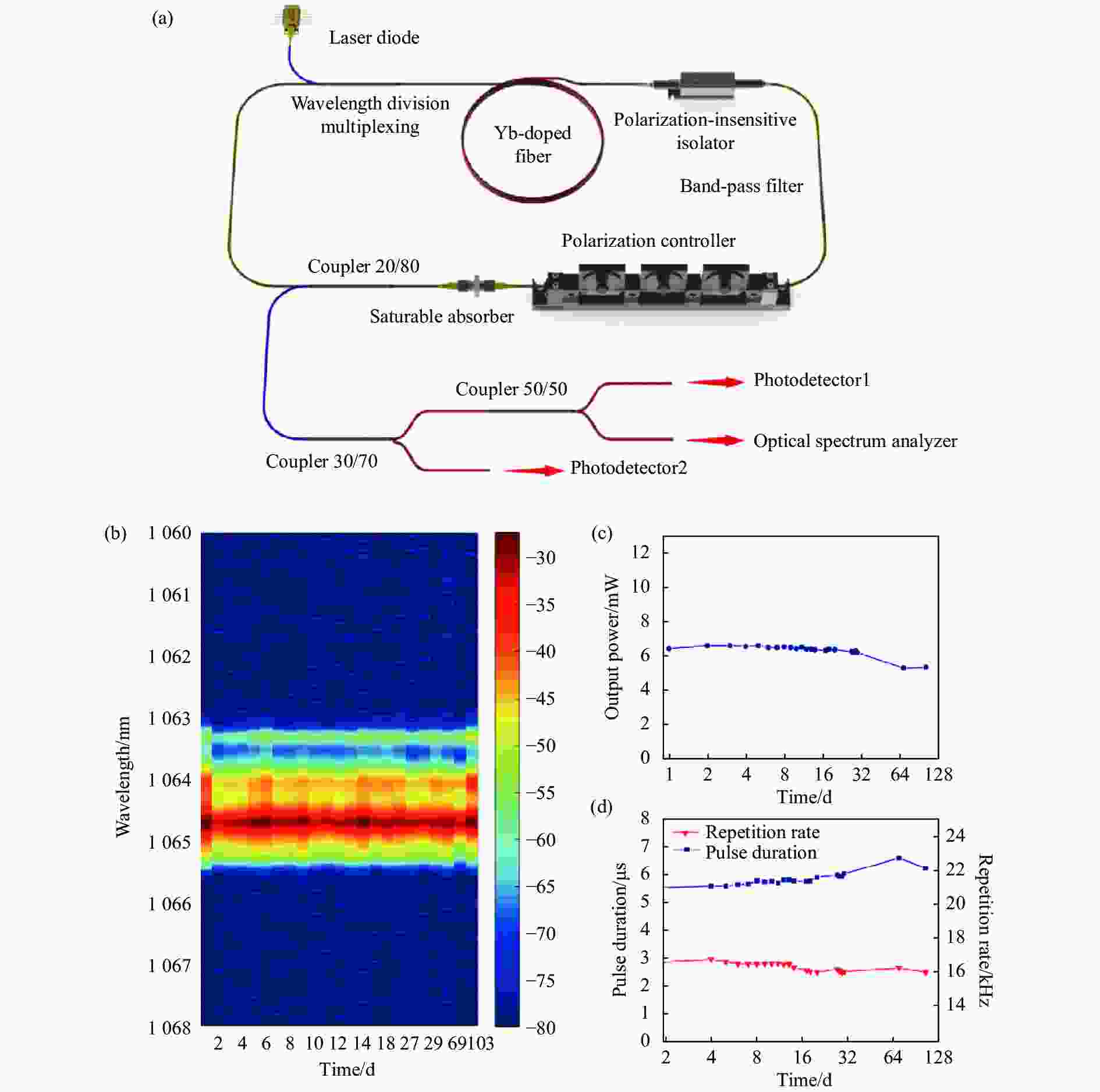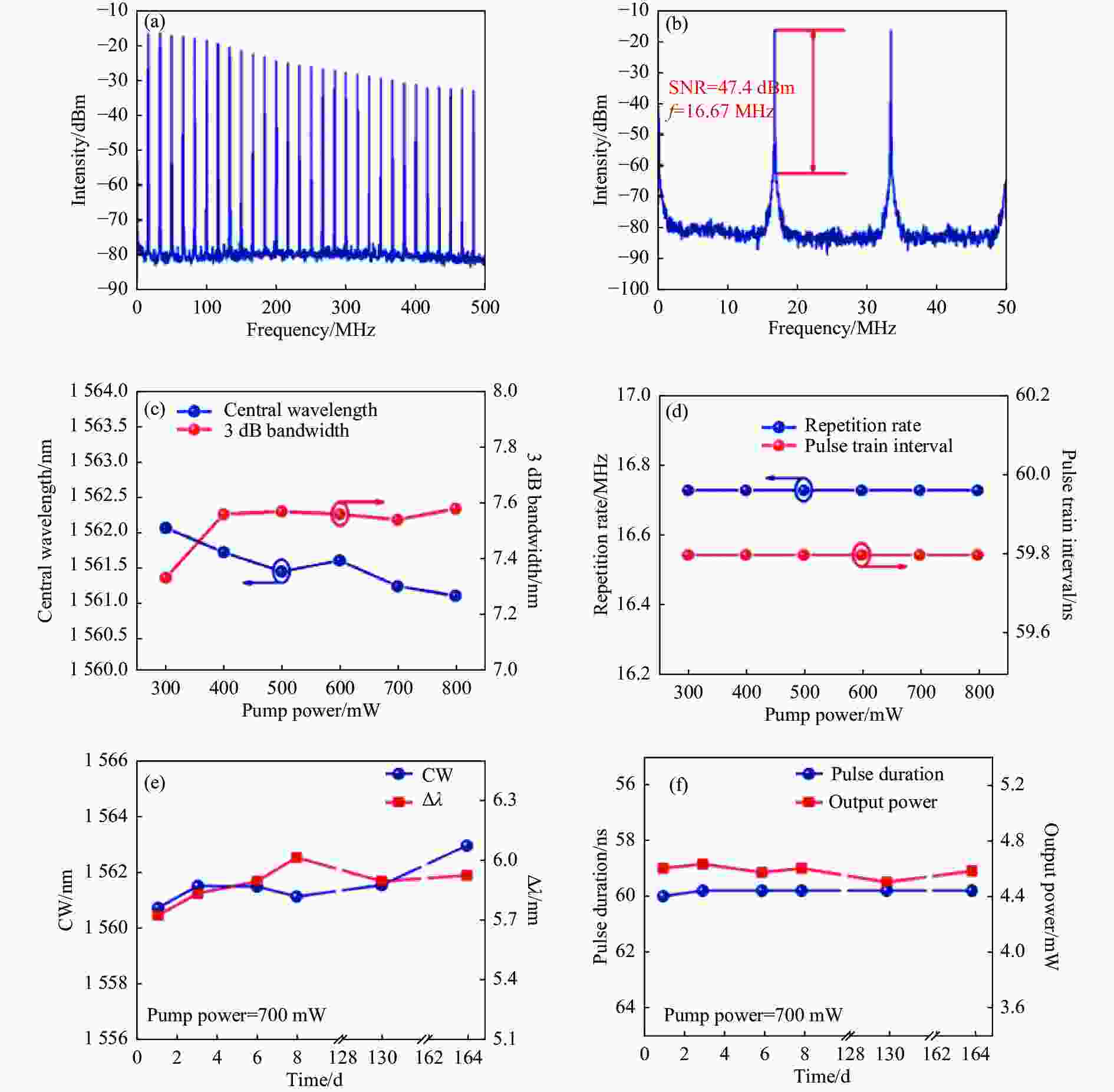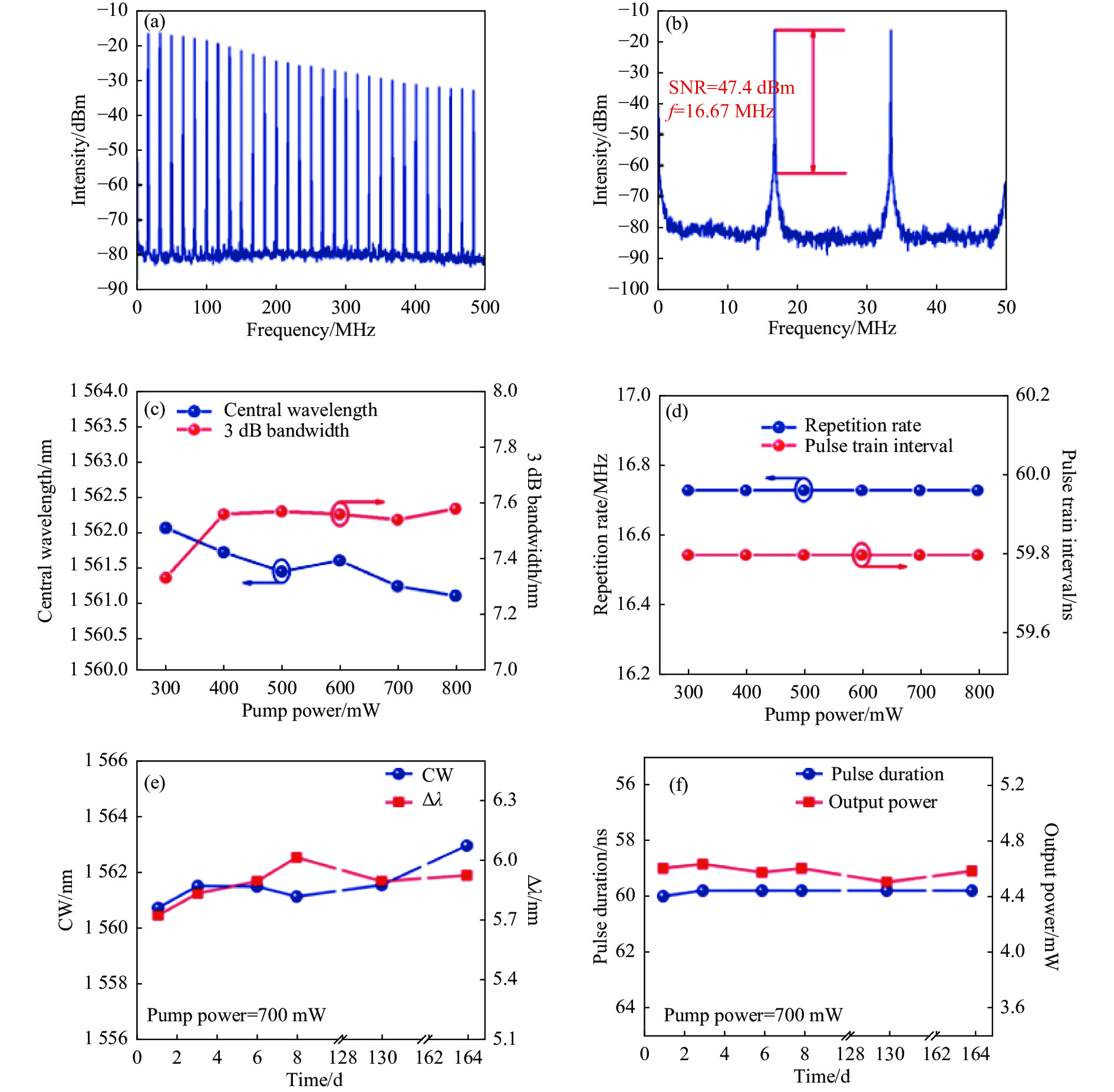-
光纤激光是20世纪以来国内激光研究与应用领域的热点,国防科技大学是国内较早开展相关研究的单位之一。“十一五”期间,学校以光纤激光相干合成、超连续谱光纤光源等科学研究为主,正式启动光纤激光学科方向的相关工作,取得了千瓦光纤激光相干合成系统[1]、高功率近红外超连续谱光源等为代表的研究成果[2-3]。“十二五”期间,学校以高功率光纤激光为主题,研究方向逐步拓宽至高功率光纤激光器[4-5]、光纤无源器件[6]等方面,在级联泵浦高功率光纤激光、特殊波长光纤激光、高亮度激光合束器、高功率超快激光等方面取得创新成果[7-11]。“十三五”以来,将研究方向前置至激光光纤材料与软件设计、延伸至激光整机研制,形成全链条,取得了自主知识产权软件、虚拟仿真课程、多种类型的激光光纤、高功率高光束质量单频/窄线宽/宽带光纤激光器、级联泵浦/半导体直接泵浦高功率高光束质量光纤激光器、高功率可见光/近红外/中红外超连续谱光源、千束激光相位控制/高功率光纤激光相干合成系统等为代表的系列研究成果[12-32]。
光学工程是学校开展光纤激光的主要支撑学科,从科研项目、科研条件、科技政策、人才队伍和研究生生源等多方面支撑光纤激光研究工作。与此同时,学科交叉也对光纤激光方向的科研起到了很大的促进作用。文中从学科交叉的视角,回顾电子、材料、控制、智能、纳米等学科的知识与技能运用于光纤激光研究带来的重要研究进展,分析发展面临的挑战与机遇。
-
多束光纤激光相干合成是21世纪以来光纤激光学科方向的研究前沿和热点,被认为可以实现提升系统输出功率的同时保持良好的光束质量[33-35]。对多束激光的相位进行有效控制是实现相干合成的基本条件之一,控制方法主要可分为“被动相位控制”和“主动相位控制”两大类[36-37]。其中“被动相位控制”通常采用全光学方法实现;而“主动相位控制”通常通过光电探测、电子学处理和电光效应机制等实现相位的探测和控制,控制带宽随着激光功率提升(相位噪声增强)和激光路数增多而下降的技术挑战普遍存在。
为提高在强噪声、大阵元条件下的相位控制能力,学校科研人员充分借鉴电子学科的相关原理与技术,将其引入光纤激光相干合成系统。
-
多抖动法是一种典型的主动相位控制算法。基于该技术的CBC系统中,每个子光路作为一个通道都有单独的相位控制模块,分别使用不同频率的调制信号进行调制。合成后的光一部分进入信号处理电路进行解调,分别解算出每一个子路的相位误差,而后作为控制信号反馈给相位调制器,实现各路子光束的锁相。这个机制类似于通信中的频分多址(FDMA)。随着阵元数目的增加,多抖动技术的调制信号范围以及相位控制硬件成本急速增加。介于此,研究团队自主研发了基于时分多址(TDMA)的单频抖动法[38]。如图1所示,不同于多抖动法,单抖动法中每个通道的调制信号具有相同的调制频率,各通道的相位调制和解调分时段进行。当一个通道处于相位调制状态时,其他子光路的信号保持不变。单频抖动法只需要一个相位控制模块,相比于多抖动法实验装置更紧凑,相位控制电路更简单,对应的硬件成本更低。

Figure 1. Phase locking based on time division multiple access[38]
-
码分多址(CDMA)是提高通信容量的有效方法。该技术通过准正交编码区分用户,实现多个用户同时共享同一频段的同一通信信道[39]。参考CDMA技术,研究团队在CBC中使用一组相同频率的“正交信号”进行相位调制和解调,同时补偿不同通道的相位误差。如图2所示,实验基于四个正交信号实现了五路CBC锁相[40]。当相位控制系统处于闭环状态时,残余相位误差小于λ∕30,CBC系统的相位控制速度比单频抖动技术提高了近11倍。

Figure 2. Phase locking based on code division multiple access[40]
-
除了采用相干合成技术不断提高激光器的性能外,实现单纤高功率高光束质量激光输出也是光纤激光技术领域的前沿热点[41]。高光束质量激光的功率提升面临着非线性效应、模式不稳定效应等因素的限制,早期的解决方案更加侧重于技术层面,比如通过增大光纤模场面积[42]、缩短光纤长度[43]、优化泵浦方向[44]等手段抑制非线性效应,通过增加种子激光功率[45]、优化弯曲半径[46]、降低激光噪声[47]等方式抑制模式不稳定效应等,但上述方式往往难以兼顾抑制两种效应。
近年来,学校科研人员更加重视从激光光纤材料本身出发,在研究光纤掺杂离子组分/配比、镱离子配位场等因素对光纤性能影响的基础上,进一步从光纤的横、纵向参数维度优化着手,设计并制备具有非线性效应和模式不稳定效应抑制功能的激光光纤,在部分掺杂光纤、低数值孔径光纤、沟壑光纤、偏振保持光纤以及锥形光纤等特种光纤的设计、制备及表征方面开展了系统的研究,并取得了良好的效果。相关研究得到了国家重点研发计划、国家自然科学基金项目等支持。
在光纤材料横向参数控制方面,针对光纤纤芯的掺杂分布、折射率调控开展了研究,典型的光纤设计包括部分掺杂光纤和低数值孔径光纤。其中,部分掺杂光纤是指在纤芯选择性掺杂稀土离子的光纤,通过控制掺杂分布可以对不同模式的增益进行调控,从而实现特定模式主导的激光输出。通过优化掺杂分布设计及光纤制备工艺,研制出了高性能中心部分掺杂光纤(光纤横截面结构示意图如图3(a)所示),并验证了该光纤在模式不稳定效应抑制方面的优势[48],支撑实现了10.1 kW的高亮度宽谱激光输出[22]以及6 kW级高亮度窄线宽激光输出[49],性能指标达到国际领先水平。低数值孔径光纤通过降低纤芯与包层的折射率差,可以在实现大模场面积的同时减少光纤支持的模式数量,从而有助于实现高功率高光束质量激光输出,目前基于自研大模场低数值孔径光纤已经实现了5 kW级近单模激光输出,为同类光纤实现的最高输出功率水平。

Figure 3. Illustration of fiber structure. (a) Confined-doped fiber; (b) Single-trench fiber; (c) Polarization-maintaining fiber; (d) Tapered fiber
上述两种光纤均通过对光纤纤芯横向参数进行设计实现高亮度激光输出。对光纤包层横向结构参数进行设计也有望实现高光束质量激光的功率提升,典型的光纤设计为沟壑光纤和偏振保持光纤。通过在光纤包层环绕纤芯设置低折射率/高折射率交替分布的环形层制备沟壑光纤,典型的单沟壑光纤横截面结构如图3(b)所示。通过控制环形层的层数、折射率以及厚度可以将纤芯中的高阶模耦合到环形层中,进一步利用弯曲损耗实现高阶模滤除,从而实现高功率近单模激光输出,团队近年来持续开展了单沟壑光纤研究[50],提出沟壑光纤的优化设计方案,并在实验中相继获得了800 W近单模激光[51]及1.5 kW高光束质量激光输出[52]。此外,为了提升线偏振激光的输出功率,学校研究人员解决了应力型偏振保持光纤(光纤横截面结构示意如图3(c)所示)的预制棒高精度深打孔问题,并通过优化包层结构参数设计解决了功率提升过程中激光偏振度显著退化的难题,成功将线偏振窄线宽激光的输出功率提升到5 kW[53],是当前线偏振窄线宽激光的最高功率水平。
在光纤材料纵向参数控制方面,主要针对光纤芯径的纵向分布开展研究,典型的光纤设计为锥形光纤,该类光纤是指纤芯尺寸沿光纤长度渐变的光纤,根据锥区形态可分为长锥形光纤、纺锤形光纤以及马鞍形光纤,其结构示意图如图3(d)所示。该类光纤在放大自发辐射抑制、光束质量保持、非线性效应及模式不稳定效应抑制等方面具有独特优势。学校科研团队针对锥形光纤开展了深入研究,通过对锥形光纤的纤芯尺寸及锥区分布等参数进行精细设计,实现了400 W级近单模单频激光输出[54]、4 kW级近单模窄线宽激光输出[55]、万瓦级高亮度宽谱激光输出。
上述高性能激光的功率突破都依托于激光光纤材料方面的研究。在此基础上,未来将进一步开展掺杂离子组分及精确配比、镱离子配位场调控以及精确拉丝控制等方面的研究,对光纤材料的微观参数(离子掺杂)和宏观参数(物理结构)进行综合调控,优化光纤材料的多维度参数,研制高性能激光光纤,推动高性能光纤激光器进一步发展。
-
波形可定制的脉冲光纤激光在先进制造、科学研究等领域具有重要应用需求。例如,使用时域特性可控的脉冲光纤激光(如振幅强弱组合型脉冲、脉宽可调的双脉冲、阶梯脉冲等)可以提高激光材料加工质量以及加工效率,使用三角形脉冲结合交叉相位调制(XPM)或自相位调制(SPM)可以实现全光波长转换、脉冲压缩以及信号再生等[56]。
目前,高功率光纤激光器主要采用主振荡功率放大结构,种子激光后接一级或多级放大器进行功率放大。脉冲激光种子能量较小时,光纤放大器对其的增益可看作线性,输入脉冲波形与对应的输出脉冲波形几乎一致。输入脉冲能量增大到一定程度后会出现增益饱和效应,放大器增益曲线转为非线性形式,脉冲前沿的增益按指数规律增加,脉冲后部的增益逐渐减少,导致输出的脉冲波形发生畸变。
为了克服增益饱和效应造成的脉冲波形畸变,可以对输入脉冲波形进行整形,预补偿放大过程中的波形畸变,最终获得目标脉冲波形。其中,获取具有预补偿效果的输入脉冲波形是实现脉冲波形定制的关键。已知放大器精细模型时,可以采用逆向计算法,直接计算需要的输入波形[11]。该方法操作简单,但对光纤系统模型要求较高,不适合多级放大等复杂光纤链路。研究团队采用正向迭代法获取目标脉冲输出需要的输入脉冲。该方法将光纤放大器系统做黑箱处理,不考虑具体放大器参数,在探测实时输出脉冲波形的基础上,基于优化算法迭代更新输入的脉冲波形,直至光纤放大器的输出脉冲波形逼近目标波形。如图4所示,团队在实验中对连续种子施加电驱调制获得脉冲激光,后接光纤放大器进行功率放大。通过SPGD算法优化调制器的电信号,实现对光纤放大器输入脉冲波形的调控,最终获得了矩形、椭圆形等多种指定脉冲波形,目标脉冲和实际输出脉冲峰值功率的相对误差小于1%[57]。
上述脉冲波形定制的实现是控制学科与光纤激光交叉融合的结果,本质是通过引入反馈机制应对光纤放大器因输入脉冲种子状态变化造成的增益参数不定性问题。如图5所示,该思路可以进一步推广应用至光纤激光时频特性的精细控制,综合多种控制策略,解决复杂非线性效应下光纤激光系统模型认知不足、环境随机干扰难以避免等造成的模型和环境不定性问题。
-
作为一种特殊结构的波导,光纤中传输电场的横向稳态分布以特定的本征模式或本征模式的叠加形式存在,光纤中传输的模式是光纤激光特性的核心参数之一。模式分解作为获得模式组成信息的关键技术一直是光纤激光技术研究领域的重要组成部分。更高精度、更快速度的模式分解技术在少模光纤激光通信[58]、大模场面积高功率光纤激光模式不稳定性[59-60]以及多模非线性效应[61]等研究领域有着重要意义。此外,光束传播因子M2是评估激光束质量的重要参数,商用M2测量装置结构较为复杂且测量耗时相对较长,而采用模式分解的方案,利用重构的光场进行光束质量因子的计算,可实现光束质量的快速测量。
当前,模式分解的主要技术方法可分为依赖特定器件和参考光的实验室测量法,例如空间光谱成像法(Spatially and Spectrally Resolved Imaging,S2)[62]和相关滤波法等,然而这类方法的分解速度往往较慢,需要光源具有一定谱宽,且相关光学器件较难制备,通用性不佳。另一类方法不依赖于关键器件以及繁琐的实验步骤,仅利用计算机对光纤激光输出的近场或远场光强分布进行算法重构从而获得模式信息,采用先进的智能算法是该类方法的重点研究方向。早在2005年,美国麻省理工学院的Shapira等就采用一种相位恢复(Gerchberg-Saxton,GS)算法成功实现了模式分解。类似的方法还有线搜索(Line-search)算法[63],该方法通过枚举不同模式系数组合的方式重构出与待测光强分布最接近的光斑,以该光斑对应的模式组成成分作为模式分解的结果。然而上述两种算法需要大量的迭代步数,计算时长较长且随着模式数目的增加而快速增加,并且严重依赖于初值的选择,因此并未得到广泛应用。
在相关领域,学校开展了特色研究工作。为解决GS和线搜索算法迭代步骤过多的问题,2013年,吕海斌等首次采用随机并行梯度下降(Stochastic Parallel Gradient Descent, SPGD)算法成功实现了模式分解[64]。SPGD算法是一种多变量优化算法,在模式分解应用中,SPGD算法将沿着给定初始值的正反两个方向施加微扰,得到两组不同的重构光强分布,并计算重构光强与待测光强的相关系数,根据相关系数的相对大小和变化梯度更新模式系数,以此过程不断迭代,最终得到分解结果。需要注意的是,这种优化算法的迭代时长较为依赖于给定的初值,单次分解时间在2~10 min左右。考虑到实际系统采集的连续两幅光斑图像之间存在一定的相关性,在前述工作的基础上,黄良金等将前一幅光斑图像分解结果作为下一幅光斑分解的初值,从而大大提高了基于SPGD算法的模式分解的速度,达到了9 Hz[65]。目前,基于SPGD算法的模式分解方案已经得到了较为广泛的关注,已相继报道了基于SPGD算法的模式分解的多种优化方案[66]。另一方面,随着人工智能技术的不断进步,在光纤激光领域也得到了广泛应用[67]。
2019年,安毅等首次提出了基于深度学习的模式分解方法[68],其基本过程如图6(a)所示:在计算机中生成若干随机模式成分及其对应的光斑图像作为学习样本,对卷积神经网络(Convolutional Neural Network, CNN)进行训练,使得训练好的网络可实现从测得的光斑图像中通过非线性映射关系而得到模式信息,利用该网络成功实现了每秒30帧图像的分解速度,分解速度的提升受限于有监督深度学习中引入的模间相位筛选过程。在三个本征模式的情况下,对实验中采集到的待测光斑进行模式分解后,依据分解结果得到的重构光斑与待测光斑平均相关度达到0.9719 (该数值越接近于1表示分解精度越高)。图6(b)绘制了实验中相关度随光斑图像帧数的变化情况,并给出了一些典型的待测光斑、重构光斑、以及相应的残差光斑[68-69]。接近于1的相关度以及重构光斑与待测光斑的高度一致性说明了CNN对光纤实时模式分解的准确性。进一步的,蒋敏等于2022年报道了基于无监督深度学习的智能模式分解技术[70]。无监督学习是深度学习中的一种重要形式,相较于基于CNN的有监督深度学习模式分解方法,它的优势在于可实现从光强图像到复值模式系数的一次性分解,而无需额外的模间相位筛选过程;此外,在不同模式数量下,无监督学习的单次分解时间相同(如3~10个模式的情况下对应的平均分解时间仅为1.7 ms),这有利于实现分解具有更多模式数目的光纤激光。无监督学习还可根据实验采集的光强图像不断更新优化网络性能,提升模式分解能力。

Figure 6. (a) Schematic diagram of pattern decomposition principle based on deep learning; (b) Application example diagram of pattern decomposition based on deep learning[69]
利用模式分解对少模光纤输出激光进行光束质量测量的方法是模式分解技术的一项重要应用。2011年,耶拿大学的Schmidt等人利用空间滤波模式分解方案对待测光斑进行模式分解后,利用重构光场计算不同位置处光斑大小进而测算出光束质量M2因子的大小。基于在模式分解领域较为深入的研究和深厚的积淀,国防科技大学相继提出了基于SPGD算法以及人工智能算法的M2因子测量技术[71-72]。特别的,蒋敏等人提出的基于主成分分析空间降维与浅层神经网络相结合的M2因子测量方法,在三个模式数情况下最高单次测量时间仅为3 ms,平均测量误差为0.95%[73],为高精度、低速率、低成本M2因子测量仪器研制奠定了技术基础。
-
光纤脉冲激光器集光纤激光器的优势和脉冲激光的特点,在非线性光学、激光雷达、光学测量、光学微加工、物质表面处理、光通讯、生物光学、生物医学技术、国防安全等诸多领域都有扮演着重要的角色,一直以来都备受各国科研工作者的关注[74]。纳米学科是当前科学前沿,与纳米学科交叉,利用材料的新特性满足光纤激光的需求,可以实现长时间稳定高新能脉冲光纤激光。当前,利用纳米材料作为真实材料可饱和吸收体产生脉冲激光已实现皮秒乃至飞秒量级的脉冲激光输出[75-76]。但是,目前二维材料可饱和吸收体仍然存在不足:一方面,受限于材料的特性,很多二维材料可饱和吸收体在空气中长时间暴露容易导致变性,无法使激光器长时间稳定工作;另一方面,一些二维材料可饱和吸收体的损伤阈值较低,容易被高强度激光照射损坏,使用纳米可饱和吸收体被动调制的脉冲激光器长时间稳定工作便难以得到保证[77-79]。创新纳米材料制备及优化可饱和吸收体器件的制备工艺,可以获得超长稳定输出的多种形式的脉冲激光[80-81]。
-
黑磷具有较大的三阶非线性[82-83], 带隙调节范围大,弥补了零带隙(石墨烯) 和 2 eV 带隙(过渡金属硫化物)之间的带隙空白,实现了从可见光到中红外波段的饱和吸收[84]。由于其独特的光电特性受到了广泛的关注,成为脉冲光纤激光极具潜力的候选调制器件之一。
将黑磷样品作为可饱和吸收体应用于掺镱光纤激光中实现脉冲输出。实验首先搭建了如图7(a)所示的环形腔结构的振荡器。黑磷可饱和吸收体薄膜附着在一个清洁的跳线头上,并通过法兰和另一个干净的跳线头相连接,形成一个饱和吸收体装置,起到进一步隔绝灰尘的作用。研究结果发挥了黑磷特有的优点,突破了常规黑磷易与氧气、水等发生反应性能退化的劣势[85-86],提高了黑磷的长期稳定性[87]。
基于上述实验装置,实现了长期稳定的脉冲输出,脉冲可以稳定运行至少103天。泵浦功率为150 mW时,脉冲的输出特性如图7所示,从图7(a)~(c)可以看出,光谱具有较好的稳定性,中心波长1064.7 nm并没有发生明显大的波动,3 dB带宽也没有明显的变化。图7(d)和(e)为测得的输出功率、重复频率和脉宽的变化,其波动的标准差分别小于4.19%、1.23%和3.98%[87]。该结果和之前报道的基于其他纳米晶少层阵列的脉冲光纤激光相比,实验所获得的脉冲激光展现出了最佳的长时间稳定性。

Figure 7. (a) Pulsed Yb-doped fiber laser device based on black phosphorus; The results of pulse long time stability test: (b) Change of spectrum; (c) Fluctuation of output power; (d) Change of pulse width and repetition frequency[87]
-
钙钛矿具有优异的光电特性,利用其可饱和吸收特性可以用于脉冲激光产生,但是传统的钙钛矿材料稳定性不能满足实际应用中的稳定性要求。基于无铅卤化物钙钛矿CsCu2I3可饱和吸收体产生了超稳定的飞秒脉冲,图8总结了光纤激光器输出脉冲的详细特性,宽带射频频谱如图8所示。图8(a)中,在0~500 MHz范围内没有杂散边带,这进一步表明了锁模光纤激光器的相对高的光谱纯度。此外,如图8(b)所示,0~50 MHz范围内,激光器的基频为16.7 MHz,信噪比为~49 dB,表明了激光器良好的稳定性。图8(c)显示了不同泵浦功率下中心波长(CW)和3 dB带宽(Δλ)的变换,随着泵浦功率的增加,中心波长从1562 nm略微下降到1561 nm,表明CW具有蓝移现象。同时,3 dB带宽从5.72 nm增加到6.01 nm。图8(d)表明不同泵浦功率下激光器的重复频率和脉冲间隔几乎没有变化。因此,上述数据表明该激光器具有良好的性能。

Figure 8. Output pulse performance of ultrafast pulse fiber laser based on the CsCu2I3-SA. (a) Recorded RF spectrum within the 500 MHz range; (b) RF spectrum within the 50 MHz range; (c) Central wavelength and 3 dB bandwidth and (d) repetition rate and pulse train interval as a function of pump power; The changes of (e) the central wavelength and 3 dB bandwidth, and (f) the output power and the pulse train interval within 164 days under the same pump power
光纤激光器的长期工作性能对于工业和科学应用尤为重要。因此,已经对基于CsCu2I3 SA的锁模激光器的稳定性进行了超过164天的测量。图8(e) 和(f)显示了在700 mW或800 mW泵浦功率下的稳定性测试结果。在实验室环境中,脉冲激光器可以稳定运行五个月以上。如图8(e)所示,激光光谱相对稳定,因为中心波长变化缓慢,3 dB带宽在5.8 nm上下略有波动,呈现出随时间缓慢上升的趋势。在图8(f)中,输出功率和脉冲间隔随时间的变化分别小于2.6%和0.33%,这表明激光器在五个月内非常稳定。此外,SA在环境中的稳定性在光纤激光系统中起着至关重要的作用。在该实验中,激光器的稳定性提高的主要原因如下。一方面,根据以往报道的结果,Ro-ccanova和Yang等人已经证明CsCu2I3薄膜在60天内表现出良好的环境稳定性。同时,通过DFT计算,评估了在300~1500 K下的热稳定性。因此,CsCu2I3微棒具有良好的湿度、热稳定性和长期稳定性。另一方面,CsCu2I3 SA封装在光纤跳线头上,削弱了CsCu2I3微棒与空气、水分之间的相互作用,进一步增强了其长期稳定性。到目前为止,与之前报道的相关结果相比,基于CsCu2I3 SA的脉冲激光器显示出超强的稳定性[88]。
同时,针对1.5 μm波段的全光纤脉冲激光功率放大技术需求,研制了高稳定性的新型二维材料可饱和吸收体器件,基于自研的可饱和吸收体器件,可以实现了高稳定、双波长、谐波、飞秒等多种形式的脉冲激光输出[89-97]。通过全光纤MOPA系统对种子激光功率进行放大,使得激光输出功率获得极大突破,可获得1.5 μm波段55 W的脉冲激光平均输出功率[98]。
-
“十一五”以来,学校的光纤激光方向取得了一系列代表性研究结果,其中来自不同学科的启发起到了重要作用。但是,深入分析不难发现,相关研究主要是学科间的“借鉴”和“启发”,比如引言部分提到的光纤仿真软件的开发和1.5节提到的超长时间稳定高性能脉冲光纤激光等,更多的是熟悉“光学工程”和“软件工程”、“纳米科学”的人员在一起共同推进的结果,真正意义上的交叉学科建设和交叉科学研究内容并不多,目前几乎没有Logan Wright等那样,同时在非线性光纤光学和人工智能等多个学科领域做出重要贡献的例子[99-101]。相关科研人员的学科基础还需要进一步增强。但是,随着新一轮科技革命、产业变革的突飞猛进和教育教学方式的不断创新,为交叉科学研究和交叉学科建设提供了新的机遇,也为光纤激光方向的发展提供了广阔空间。
(1)科研范式演进。当前,人工智能驱动的科学研究(AI for Science)成为全球人工智能发展新的前沿,并已在多个学科领域取得实效。近期,国家科学技术部、自然科学基金委员会联合启动了“人工智能驱动的科学研究”专项部署[102]。在专项的支持下,将更好地培养与汇聚跨学科研发队伍。
(2)学科主体驱动。目前,光纤激光方向的研究主要依托光学工程学科,实际上,光学工程学科本身就有很强的交叉属性。截止到2022年6月30日,全国已有100多所高校自主设置了交叉学科[103],其中26个自主设置交叉学科与光学工程密切相关,例如,北京航空航天大学设置的“量子科学仪器”、“集成电路设计”,北京理工大学的“光机电微纳制造”、“智能数字表演”等。光学工程学科本身就是促进交叉科学研究的沃土。
(3)应用需求牵引。以重要科研仪器为例,“超精密测量与仪器技术是高端制造发展的前提与基础”[104],目前还存在许多关键技术亟待突破,光纤激光的研制及其特性测量仪器也是如此[105],研制采用的熔接机、切割刀、涂覆机和测试采用的功率计、光束质量测量仪和光谱仪等设备,国产设备比例不高。相关科研仪器的研发,需要组建光学工程、电子科学与技术、仪器科学与技术、控制科学与工程等多个学科的交叉研究队伍,可以很好地牵引交叉科学研究。特别是,在智能化仪器的研发方面,有望为智能科学与技术等交叉学科建设提供支撑。
(4)科教融合发展。科教融合是现代高等教育高质量发展的核心理念之一,支持教学与科研相互促进。学校光纤激光方向的建设发展过程中,也一直注重这一理念,开设了“Fundamentals of Fiber Laser”专业课程[106],并通过积极参与“光子学公开课”、开设“光纤激光技术高级培训班”等方式,加速科研成果入课堂,促进教学资源的共享与传播,起到了很好的效果。通过教育教学过程培养了大量优秀青年人才,成为光纤激光学科方向建设的“生力军”。
-
经过约15年的发展,学校光纤激光方向取得了一系列重要成果,这与光学工程学科的支持以及其他相关学科的深度交叉融合紧密相关。不断地综合发展,从综合到更大的综合,是21世纪人类科学技术发展的持续趋势,这种融合趋势体现在科学研究、学科建设、人才培养等多个方面[107]。尽管光纤激光的发展也遇到很多困难和挑战,但随着交叉学科建设和交叉科学研究的持续推进,光纤激光方向必将持续产生更多的创新成果。
Fiber laser from interdisciplinary perspective: review and prospect (invited)
doi: 10.3788/IRLA20230334
- Received Date: 2023-05-22
- Rev Recd Date: 2023-06-07
- Available Online: 2023-07-04
- Publish Date: 2023-06-25
-
Key words:
- optical engineering /
- interdisciplinary /
- fiber laser /
- coherent synthesis /
- pulsed laser
Abstract:












 DownLoad:
DownLoad:






